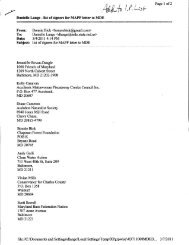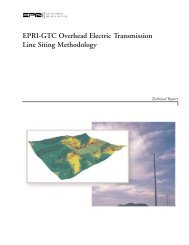Mid-Atlantic Power Pathway Chalk Point Substation to Indian River ...
Mid-Atlantic Power Pathway Chalk Point Substation to Indian River ...
Mid-Atlantic Power Pathway Chalk Point Substation to Indian River ...
You also want an ePaper? Increase the reach of your titles
YUMPU automatically turns print PDFs into web optimized ePapers that Google loves.
<strong>Mid</strong>-<strong>Atlantic</strong> <strong>Power</strong> <strong>Pathway</strong> Environmental Review Document<br />
<strong>Chalk</strong> <strong>Point</strong> <strong>Substation</strong> <strong>to</strong> <strong>Indian</strong> <strong>River</strong> <strong>Substation</strong> Volume II – Environmental Analysis of<br />
April 13, 2011 <strong>Chalk</strong> <strong>Point</strong> <strong>Substation</strong> <strong>to</strong> MD/DE State Line<br />
Table 1.2-1 (continued)<br />
Soil Series Within the Project Right-of-Way and Project Boundaries<br />
Soil Series Description<br />
Wist The Wist series consists of deep well drained soils on uplands. They formed in Coastal<br />
Plain sediments containing moderate amounts of glauconite. Typically these soils have a<br />
dark brown sandy loam surface layer 11 inches thick over 2 inches of brown sandy<br />
loam. The dark brown subsoil from 13 <strong>to</strong> 29 inches is sandy clay loam and from 29 <strong>to</strong><br />
32 inches is sandy loam. The dark brown substratum from 32 <strong>to</strong> 44 inches is sandy loam<br />
and from 44 <strong>to</strong> 80 inches is loose sand. The parent material consists of glauconite<br />
bearing loamy fluviomarine deposits. Depth <strong>to</strong> a root restrictive layer is greater than 60<br />
inches. Water movement in the most restrictive layer is moderately high. Available<br />
water <strong>to</strong> a depth of 60 inches is moderate. Shrink-swell potential is low. This soil is not<br />
flooded. It is not ponded. A seasonal zone of water saturation is at 45 inches during<br />
January. Organic matter content in the surface horizon is about 4 percent. This soil does<br />
not meet hydric criteria.<br />
Woods<strong>to</strong>wn The Woods<strong>to</strong>wn series consists of deep, moderately well-drained soils on uplands and<br />
terraces. They formed in marine and alluvial Coastal Plain sediments. Typically, these<br />
soils have a dark grayish-brown sandy loam surface layer 7 inches thick and a<br />
subsurface layer from 7 <strong>to</strong> 11 inches of light yellowish-brown sandy loam. The light<br />
olive brown sandy clay loam subsoil, from 11 <strong>to</strong> 29 inches, is mottled in the lower part.<br />
The substratum layers from 29 <strong>to</strong> 70 inches are sandy loam and loamy sand. This soil is<br />
moderately well drained. The slowest permeability within 60 inches is moderately slow.<br />
Available water capacity is very high and shrink swell potential is low. This soil is not<br />
flooded and is not ponded. The <strong>to</strong>p of the seasonal high water table is at 30 inches.<br />
There are no saline horizons. This component is not a hydric soil.<br />
Zekiah The Zekiah series consists of very deep poorly drained soils located on flood plains of<br />
the <strong>Mid</strong>-<strong>Atlantic</strong> Coastal Plain. They formed in loamy fluvial sediments overlying sandy<br />
sediments. Typically these soils have dark brown silt loam surface 3 inches thick. The<br />
subsurface is mottled dark grayish brown silt loam 17 inches thick. The substratum is<br />
mottled and is dark gray and grayish brown sandy loam then stratified sand down <strong>to</strong> 72<br />
inches. The parent material consists of loamy alluvium. Depth <strong>to</strong> a root restrictive layer<br />
is greater than 60 inches. Water movement in the most restrictive layer is moderately<br />
high. Available water <strong>to</strong> a depth of 60 inches is high. Shrink-swell potential is low. This<br />
soil is frequently flooded. It is frequently ponded. A seasonal zone of water saturation is<br />
at 5 inches year-round. Organic matter content in the surface horizon is about 4 percent.<br />
This soil meets hydric criteria.<br />
1.2.1.1 Description of Potential Soil Limitations<br />
Some soil types have characteristics (e.g., erosion potential, hydric soils, compaction potential) that make<br />
them more susceptible <strong>to</strong> certain impacts or that make them valuable for specific purposes (e.g.,<br />
farmland). These various “soil limitations” are discussed for each of the Project components in the<br />
following sections. In addition, Tables 1.2-2 through 1.2-7, respectively, present the known soil<br />
limitations of the soil map units for each Project component. Note that the acreages presented in the<br />
tables below are estimates based on projected disturbance areas and available soil mapping data (USDA-<br />
NRCS 2010). The actual soil conditions at a given location might vary from the generalized soil mapping<br />
presented by this data. Potential impacts discussed below are limited only <strong>to</strong> those areas where there<br />
would be temporary and/or permanent ground disturbance [construction entrances, <strong>to</strong>wer foundations,<br />
1-28




